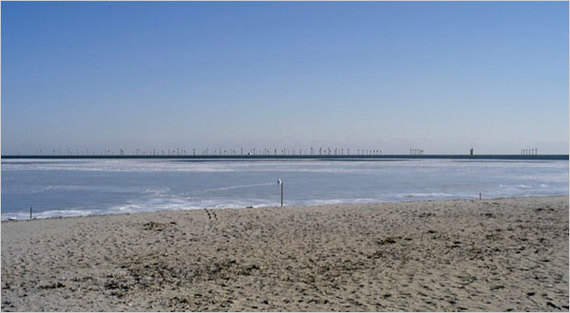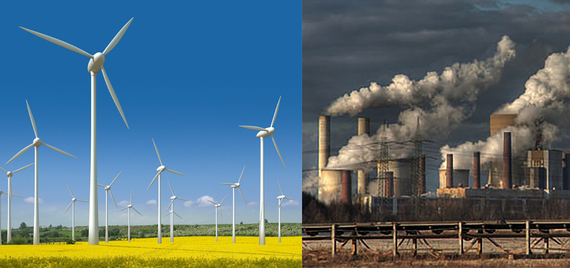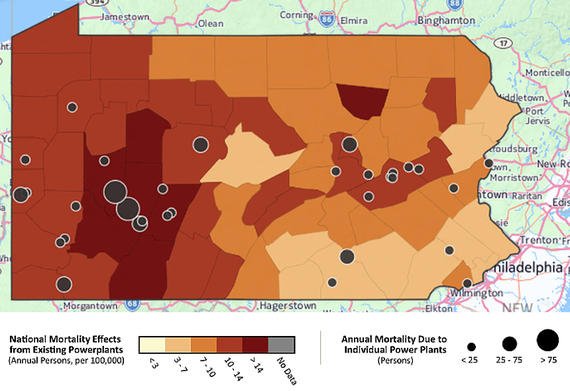The Aussies don't like the look of wind energy, it seems.
A few weeks ago, Australian Prime Minister Tony Abbott called wind farms "visually awful," and last year the country's Treasurer described them as "appalling" and "utterly offensive." Over the past year, Australian investment in renewable energy reportedly has dropped by 90 percent, and Abbot says his government is working hard both to reduce the number of wind farms and increase the number of coal mines.
What's going on Down Under? An island country with enormous amounts of open space, Australia is perfect for wind energy. The benefits are clear, according to the US Department of Energy (DOE): it's clean, inexhaustible, and affordable (equivalent to natural gas), and unlike most electric power plants, it doesn't require water. Converting the U.S. to 20 percent wind power would save 4 trillion gallons of water a year. Finally, it can help create both jobs and energy security.
Opponents say that wind farms harm the land, wildlife, and human health all at once. Yet, the National Renewable Energy Laboratory has shown that, unlike coal mines and coal-fired power plants, wind farms cause little or no temporary or permanent damage to land use. The National Wind Coordinating Committee exhaustively studied the published research on how wind energy affects birds and other species and concluded that the risks are minimal or non-existent. Regarding human health, wind farm neighbors in some locations have complained of dizziness, headaches, stress, and lack of sleep, supposedly due to low-frequency noise, or "infrasound," but in the past few years a variety of sources, including the DOE, MIT, the Union of Concerned Scientists, Health Canada, and the Australian government itself, have found no scientific evidence to support these claims.
According to a 2013 Gallup poll, 71 percent of American want more wind energy, and last fall 87 percent of Midwesterners surveyed said they favor increasing the number of wind farms. Yet, like Tony Abbott, many complain that wind farms are unsightly. In fact, North Carolina has tried to pass a bill banning wind energy--purely for aesthetic reasons. Even some supporters of wind farms hate the way they look. Texas financier T. Boone Pickens, a vocal champion of wind energy, told Forbes magazine, "There are no turbines on my ranch, because I think they are ugly."
Not everyone agrees. Wind energy production in the Czech Republic, a place known for its scenic beauty, has grown by sixteen times over the past decade. In a 2011 survey of tourists there, 90-95 percent felt that wind turbines didn't cause the region to be less attractive or desirable to visit, and most felt that power lines and cell phone towers -- ubiquitous in most places -- are more of an eyesore.
Besides, which is more "visually awful" -- a wind farm or a smog-belching coal plant?
There's the rub. Typically, traditional power plants are located in poorer communities, hidden out of sight from middle- or higher-income residents. Wind farms, on the other hand, often are in highly visible spaces -- open fields, farms, and waters -- and this makes them subject to greater scrutiny. In that Czech survey, the only people who objected to the wind farms were local residents.

Rendering of what Cape Wind, the first offshore wind farm in the U.S., would look like from the coast of Nantucket Sound. Source: Cape Wind Associates.
A dozen years ago, private developers proposed building 130 turbines, half of a mile apart, across Nantucket Sound, several miles off the coast, and the project has been mired in controversy ever since. The first offshore wind project in the U.S., Cape Wind could generate 1,500 gigawatt hours of electricity, 75 percent of the region's needs. Yet, locals -- in large part businesses and wealthy homeowners -- object to the plan because, they claim, Nantucket Sound is "a special place that should be kept natural and free of human intrusion." A Greenpeace spokesperson dismissed this as "an elitist and local view," since Nantucket is filled with "mega boat traffic and jet skis and fishing boats and ferries" -- not exactly free of human intrusion.
When Cape Wind was first proposed, renowned broadcaster and long-time Martha's Vineyard resident Walter Cronkite told the New York Times that the project "will be most unsightly... I'm all for these factories, but there must be areas that are far less valuable than this place is." Reported the Times: "With prodding, he suggested the deserts of California. Then, perhaps realizing that might be a tad remote to serve New England's energy needs, he added, 'Inland New England would substitute just as well.'" Anywhere but here.
Coal remains the single largest source of power in the U.S. (39 percent). According to the Clean Air Task Force, a decade ago emissions from U.S. power plants caused more than 24,000 deaths every year, but state and federal regulations cut that number nearly in half -- to 13,000 -- by 2010. This number exactly matches the U.S. homicide rate that year (12,996). A six-county cluster in Western Pennsylvania consistently has some of the highest mortality rates -- over 14 for every 100,000 people--due to the impact of coal-fired power plants. Indiana County, which has been ranked among the "dirtiest" in the country for carbon emissions, has four hot spots where the death rate can exceed 75 per 100,000. Indiana County also has the state's third-highest poverty rate --18.6%, four points higher than the national average.
The legal definition of environmental equity is "equitable sharing of environmental impacts by a community." According to the US EPA, "no group of people should bear a disproportionate share of the negative environmental consequences." When Pickens and others support wind energy but believe it has negative consequences -- even just aesthetic ones -- they are saying precisely that a disproportionate share of those consequences should be borne by others. They believe that energy infrastructure should be concealed in Indiana County and other places that are, in Cronkite's words, "far less valuable."
Coal kills, and alternative energy can help save lives. But only if ethics can overcome aesthetics.
Architect Lance Hosey's latest book is The Shape of Green: Aesthetics, Ecology, and Design. Follow him on Twitter: @lancehosey


